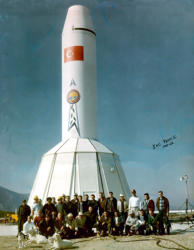
HISTORY - Page 6
were salient questions to be answered. These involved the degree of accuracy that could be achieved,
reliability of guidance systems that might be employed, and whether or not problems in either case could
be speedily resolved
7
.
This was but one move in the slightly quickened pace leading toward action, for, on 25 March, the Assistant
Chief of Staff, G-3 (Training), recommended the initiation of the 1,000 to 1,500 mile missile development
program. Additionally, CONARC began reviewing and updating its 1954 conceptions. Proposals for short
range remained the same, with the 75-mile SERGEANT being considered as the best solution to meet this
requirement. In the medium-range field, development of a 250-mile missile was proposed to replace the
suggested 150-mile weapon. As for long-range missiles, CONARC did not make a specific suggestion. The
250-mile missile, to their thinking, deleted the 500-mile requirement; however, they believed that the Army
did require the ability to attack targets with nuclear warheads at extremely long range
8
.
By May 1955, Redstone Arsenal completed the study that had been directed by OCO in January. Basically,
this involved three missiles, the larger of which was an IRBM. No commitments were immediately
forthcoming from this or any of the other preceding proposals, but at this point recommendations from
widespread sources were centering on the requirement for a long-range missile of the IRBM class.
Redstone Arsenal quite firmly believed that it had the capability to accomplish such development, so, in
______________________________
7. House Rpt Nr 67, 0p. cit., p. 21; Memo, Dep Chf R&D to OCO, 1 Mar 55, subj: Medium Range Ball Msls, cited in DA Pam 70-10, p. 118
8. DA Pam 70-10, p. 118; Memo, CONARC to OCRD, 2 Apr 55, subj: Surface-to-Surface GM Rqmts for Spt of Corps & Larger Units, cited in DA Pam 70-10, p. 38








Jupiter SM-78 Weapon System
I&C Team 2, Çigli AB, Turkey 1961-1962 Chrysler Corporation Missile Division

HISTORY - Page 6
were salient questions to be answered. These involved
the degree of accuracy that could be achieved, reliability
of guidance systems that might be employed, and
whether or not problems in either case could be speedily
resolved
7
.
This was but one move in the slightly quickened pace
leading toward action, for, on 25 March, the Assistant
Chief of Staff, G-3 (Training), recommended the initiation
of the 1,000 to 1,500 mile missile development program.
Additionally, CONARC began reviewing and updating its
1954 conceptions. Proposals for short
range remained the same, with the 75-mile SERGEANT
being considered as the best solution to meet this
requirement. In the medium-range field, development of
a 250-mile missile was proposed to replace the suggested
150-mile weapon. As for long-range missiles, CONARC did
not make a specific suggestion. The 250-mile missile, to
their thinking, deleted the 500-mile requirement;
however, they believed that the Army did require the
ability to attack targets with nuclear warheads at
extremely long range
8
.
By May 1955, Redstone Arsenal completed the study that
had been directed by OCO in January. Basically, this
involved three missiles, the larger of which was an IRBM.
No commitments were immediately forthcoming from
this or any of the other preceding proposals, but at this
point recommendations from widespread sources were
centering on the requirement for a long-range missile of
the IRBM class. Redstone Arsenal quite firmly believed
that it had the capability to accomplish such
development, so, in
______________________________
7. House Rpt Nr 67, 0p. cit., p. 21; Memo, Dep Chf R&D to OCO, 1 Mar 55, subj: Medium Range Ball Msls, cited in DA Pam
70-10, p. 118
8. DA Pam 70-10, p. 118; Memo, CONARC to OCRD, 2 Apr 55, subj: Surface-to-Surface GM Rqmts for Spt of Corps & Larger
Units, cited in DA Pam 70-10, p. 38





















